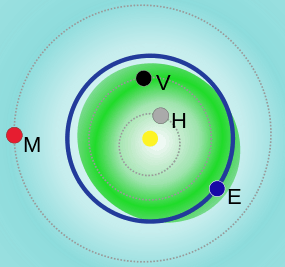Aten asteroid

|
Mars (M) Venus (V) Mercury (H) |
Sun Aten asteroids Earth (E) |
The Aten asteroids are a dynamical group of asteroids whose orbits bring them into proximity with Earth. By definition, Atens are Earth-crossing asteroids (a < 1.0 AU and Q > 0.983 AU).[1] The group is named after 2062 Aten, the first of its kind, discovered by American astronomer Eleanor Helin at Palomar Observatory on 7 January 1976. Since then, more than 1,300 Atens have been discovered, of which many are classified as potentially hazardous asteroids.[2][3]
Description
Aten asteroids are defined by having a semi-major axis (a) of less than 1.0 astronomical unit (AU), the roughly average distance from the Earth to the Sun. They also have an aphelion (Q; furthest distance from the Sun) greater than 0.983 AU.[1] This makes them Earth-crossing asteroid as the orbit of Earth varies between 0.983 and 1.017 AU.
Asteroids' orbits can be highly eccentric. An Aten orbit need not be entirely contained within Earth's orbit, as nearly all known Aten asteroids have their aphelion greater than 1 AU although their semi-major axis is less than 1 AU. Observation of objects inferior to the Earth's orbit is difficult and this difficulty may be the cause of some sampling bias in the apparent preponderance of eccentric Atens. Aten asteroids account for only about 7.4% of the known near-Earth asteroid population.[3] Many more Apollo-class asteroids are known than Aten-class asteroids, possibly because of the sampling bias.
The shortest semi-major axis for any known Aten asteroid is 2016 XK24 at 0.580 AU.[2] The Aten asteroid with the smallest known perihelion is also the one with the highest known eccentricity: (137924) 2000 BD19 has an orbit with an eccentricity of 0.895, which takes it from a perihelion of 0.092 AU, well within Mercury's orbit, to an aphelion of 1.66 AU. For a brief time near the end of 2004, the asteroid 99942 Apophis (then known only by its provisional designation 2004 MN4) appeared to pose a threat of causing an Earth impact event in 2029, but earlier observations were found that eliminated that possibility. A very small possibility of impact remained for 2036, but this was also eliminated.[4]
Atiras
There are also 18 known Atira asteroids (also known as Apoheles asteroids),[3][5] traditionally listed as a subgroup of Atens, such as by the Minor Planet Center,[2] but often regarded a separate class of their own.[1] Unlike Atens (Q > 0.983 AU), Atiras permanently stay within Earth's orbit and do not cross it (Q < 0.983 AU).[1]
| Group | q | a = 1 | Q | ECA |
|---|---|---|---|---|
| Amors | > 1.017 | larger | – | |
| Apollos | < 1.017 | larger | – | |
| Atens | – | smaller | > 0.983 | |
| Atiras | – | smaller | < 0.983 | |
| For all NEOs q is < 1.3 AU; The orbit of Earth varies between 0.983 and 1.017 AU | ||||
See also
References
- 1 2 3 4 5 "NEO Basics". NASA/JPL CNEOS. Retrieved 17 May 2018.
- 1 2 3 "List Of Aten Minor Planets (by perihelion distance)". Minor Planet Center. 17 May 2017. Retrieved 17 May 2017.
- 1 2 3 "Discovery Statistics – Cumulative Totals". NASA/JPL CNEOS. 16 May 2018. Retrieved 17 May 2018.
- ↑ "99942 Apophis (2004 MN4) Earth Impact Risk Summary". NASA. Archived from the original on 2013-05-11.
- ↑ "JPL Small-Body Database Search Engine: Q < 0.983 (AU)". JPL Solar System Dynamics. Retrieved 17 May 2018.